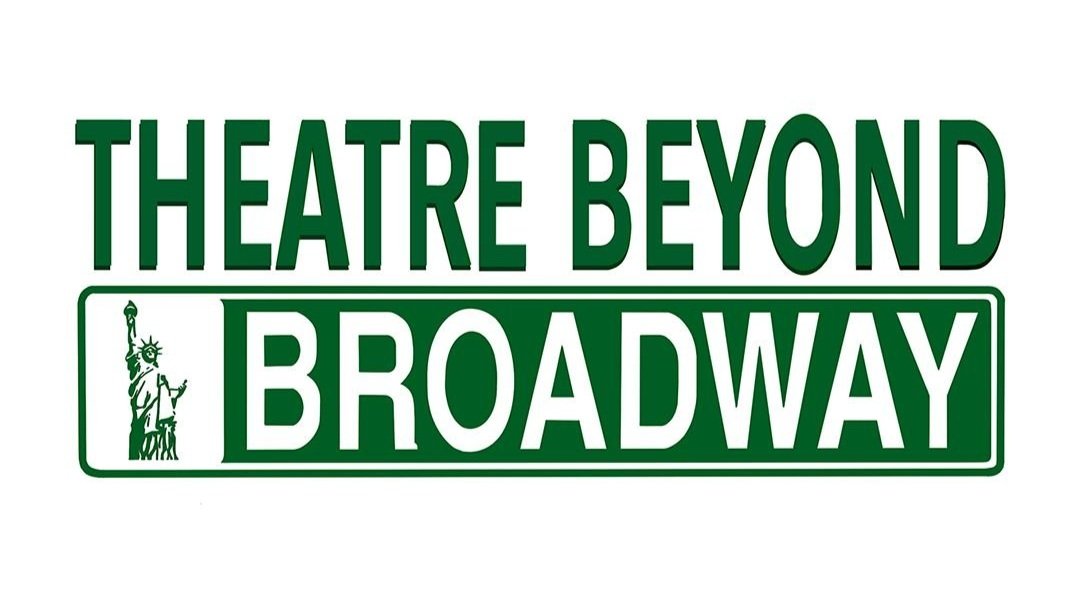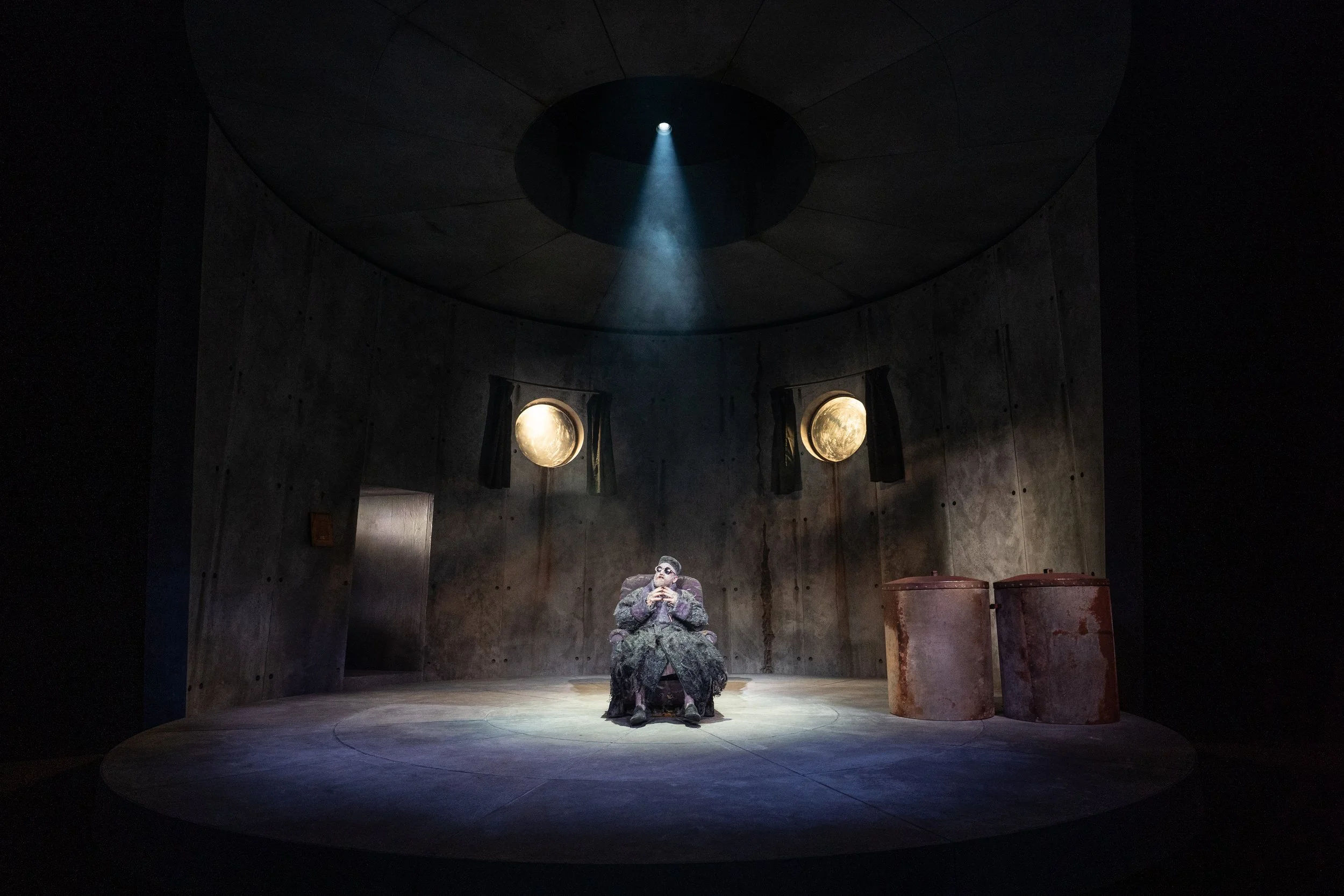Endgame
Written by Samuel Beckett; Directed by Garry Hynes
Irish Arts Center, JL Greene Theatre, 726 11th Avenue, New York, NY 10019
October 22 - November 23, 2025
Photo by HJ Chow
He rises—if one can call that tremulous ascent “rising”—with the wary gravitas of a man who must negotiate not only the physical geography of a room but the metaphysical terrain of his own being. Each incremental step is a kind of existential probe, as though he suspects the boards beneath him might hold, not traps, but truths he is not entirely prepared to receive. And then the ladder, that perverse architectural gesture to nowhere, must be carried in. It stands like a relic of some abandoned cosmology, a staircase to an absent heaven. He climbs. He draws back the curtains with a gesture half-priestly, half-mechanical, scanning a horizon whose content is withheld from us—perhaps mercifully—while emitting a chuckle that seems borrowed from that strange Beckettian dimension where mirth and despair share the same vocal register. What he sees will remain forever unwitnessed, yet the act of looking—the sheer muscularity of it—becomes the true overture. It is through these gestures that Endgame opens: a man attempting to peer into Beckett’s universe, into the raw condition of continued obedience, attention, and breath.
And then the uncovering: slow, ceremonial, almost funereal. Beneath a dirty, bloodstained sheet, a body and then beneath a dirty bloodstained handkerchief, a face. What appears is a man in a chair—still, a cipher of morbidity—and the infamous twin garbage cans, those repositories of memory, grief, and grotesquerie. The tableau is quintessential Beckett: an image pitched uncannily between comedy and catastrophe, a moment suspended at the intersection of tenderness and the absurd.
Garry Hynes, that great interpreter of psychological topography, here with Druid Theatre at the Irish Arts Center, conjures a world that feels less staged than excavated. The air seems to vibrate with the same dread-filled austerity we associate with Waiting for Godot; indeed, this production feels like a sibling to Jamie Lloyd’s Broadway staging, though where Lloyd’s Godot reached outward toward the dream—or nightmare—of arrival, Hynes’s Endgame curls inward, toward the cavern where hope has immolated itself and left only its smoke behind.
The evening announces its intentions from the very first vibrations—those subterranean, almost tectonic murmurs of Gregory Clarke’s sound design, which seem less like cues than auguries. They do not merely set the mood; they foretell it, as if the theater itself were bracing for an incursion of dread. Francis O’Connor’s set, a bowed concrete bunker whose curvature suggests both containment and collapse, amplifies this sense of impending ruin. Its circular deck and two unreachable, curtained windows evoke an architecture designed not for habitation but for exile. At the precise center lies a drain—an inscrutable aperture that intimates unsavory histories and more than a few unspeakable functions. One feels it might swallow whatever hope wanders too close.
James F. Ingalls’ lighting cuts through this hermetic world with surgical austerity: blades of illumination piercing the doorway, the inaccessible windows, and the solitary oculus above. The effect is both sculptural and punitive, arranging the space into stark geometries that resemble diagrams of despair. Even the garbage cans—those infamous reliquaries containing the dilapidated Nagg and Nell—are rendered uncanny by a diabolical uplight that makes them appear less like receptacles and more like oracular devices dredged up from some post-apocalyptic ritual. The design conjures a landscape of terminal desolation—an environment stripped to its existential studs. This is that corner of the earth where the very concept of “later” has grown dubious. And yet, as Beckett always reminds us, desolation has its own cunning wit. Within this bunker of doom, the dark comedy proliferates, blooming like nightshade in the cracks.
Hynes, ever the meticulous cartographer of human futility, furnishes the stage with a series of images that linger in the mind like aftershocks. Chief among them is Aaron Monaghan’s Clov, who seems constitutionally incapable of stillness, all flinching angles and febrile momentum, a man on the alert in a room of intimidating bumper cars. He scurries through the desiccated landscape performing tasks whose uselessness feels almost sacramental—adjusting, climbing, descending, re-climbing the ubiquitous ladder that serves as both his torment and his tether. He is the busiest soul in this blasted universe, perpetually declaring his departure with the fervor of a man promising resurrection, yet never quite achieving the simple miracle of exit. His inertia-in-motion becomes one of the evening’s great tragicomedies: a portrait of a creature doomed to circulate endlessly within the narrow circuitry of Beckett’s design.
Opposite him, Rory Nolan’s Hamm inhabits a grandeur that has rotted from the inside—a tyrant caving in on himself. His blindness extends beyond sight; it is a depletion of spirit, a monarchy presiding over dust. Entombed in his tattered recliner—an object that looks less like furniture than a final resting place—and swaddled in a robe so begrimed one can almost inhale its rancid history (a feat of costuming by Mr. O’Connor that complements his grey set), Hamm emits his days in snarls and guttural pronouncements, the way a caged grizzly might pace the limits of its captivity. He is both monarch and animal, tyrant and invalid, a creature roaring not at his captors but at the sheer indignity of continued existence. The text, ever resistant to dissection, becomes under Hynes’s sculptural touch less a puzzle than a mode of reflection. One discovers, almost inadvertently, that these characters’ paralysis mirrors our own habitual waiting: for revelation, for relief, for meaning to congeal. Hamm’s anguished inquiry—“Have you not had enough?”—circles the audience like a vulture, daring us to answer.
Then, there is the father-son repartee between Hamm and his father Nagg, awakened from his garbage can. Bosco Hogan displays that the worm-eaten apple has not fallen far from the diseased tree. As though rising from the collective unconscious, Marie Mullen’s Nell speaks from her bin. Her voice emerges like a memory of love one had nearly convinced oneself was imagined. Alongside Hogan’s Nagg, she becomes a poignant emblem of the human impulse to recall, to connect, to persist even when the world has ceased offering reasons. The effect is uncanny, even devastating: a reminder of mortality not as abstraction but as a slow, inevitable seep. Hogan and Mullen inhabit these trash-bin-bound lovers with an endearing, almost unbearable poignancy, their performances suffused with the tremulous light of recollection. As they rummage through the attic of their shared past—those fleeting instants of happiness, the half-forgotten fervor of youth—they do so not with nostalgia’s saccharine tint but with the clear-eyed tenderness of those who know their best hours have receded beyond retrieval. “Ah … yesterday,” sighs Nell, her voice a soft ruffle of memory as her fingers curl around the rim of the bin, that ignoble perch from which she gazes wistfully into the audience. In that moment, the decades collapse, and the brutal architecture of Beckett’s world momentarily yields to something at once smaller and infinitely larger: the quiet radiance of a love that persists, however faintly, even in extinction’s shadow.
Each performer wields their voice not merely as a conduit for text but as a resonant instrument in a kind of desolate chamber quartet, transmuting Beckett’s sparse verbal architecture into a four-part harmony streaked with dispossession, fury, and that unmistakable Beckettian strain of mordant humor. What emerges is less spoken dialogue than a kind of cracked liturgy, a music of survival rendered in tones that hover between lament and reprimand. This Endgame exerts a gravitational pull, completing not a narrative sequence but a philosophical orbit. While Waiting for Godot concerns two men awaiting the advent of significance, Endgame presumes that significance has died, and asks what rituals remain. Yet Hynes seasons the despair with something like stubborn vitality. Persistence—habit, cruelty, compassion—becomes a kind of cracked benediction. One keeps going because one keeps going.
Thus Endgame concludes as it must: with the sensation of a circle drawn, not closed; of an equation unresolved yet fully expressed. Druid’s production honors the stark mathematics of Beckett’s late style where inside, a handful of figures remain because they have nowhere else to go: one sits in a tattered armchair issuing decrees, another limps in circles, tending to the rituals of survival—opening curtains on a dead landscape, shuffling from corner to corner as though movement itself might stave off the void, and in the background, two older souls murmur from their bins like relics of a vanished order, offering commentary no one asked for and no one can quite bear.
In this tiny kingdom of exhaustion, each role is fixed: one commands, one obeys, two linger. But the hierarchy feels less like structure than like entropy arranging itself—an arrangement in which everyone is essential only because there is no one left to replace them. A parody of power, a parody of servitude, a parody of choice. It’s a system where each figure is trapped in a choreography of fading purpose: not kings and pawns, but survivors and their shadows, all performing their parts in a play that ended long ago, yet refuses, stubbornly, to stop…until there are none.
Endgame distills, with an almost monastic severity, Beckett’s unsettlingly beautiful cosmology—a philosophy built from the raw materials of nothingness, desolation, and the stubborn, flickering life-force that persists even when all conventional narratives of hope have been stripped away. It is a world without promise, and yet one in which the human impulse to continue—however haltingly, however absurdly—refuses to extinguish itself.
In Druid’s hands, these mysteries are not solved so much as illuminated, like etchings revealed under a late, slanted light. The company approaches Beckett with the rigor of scholars and the sensitivity of poets, rendering his bleak arithmetic not only legible but unsettlingly alive. For those who care about how Beckett should sound, should feel, should burrow into the mind, this off-Broadway venture offers as faithful and as resonant an encounter as one is likely to find. It is, quite simply, a production not to be missed.
Click HERE for tickets.
Review by Tony Marinelli.
Published by Theatre Beyond Broadway on November 17, 2025 All rights reserved.

